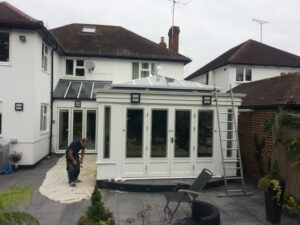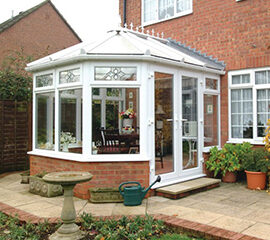Victorian Conservatories
 This style is very reminiscent of a traditional sun-room, with ornate roof lines and usually 5 or 6 faceted sides in the shape of a pentagon or hexagon, used often for p-shaped variations on larger rooms.
This style is very reminiscent of a traditional sun-room, with ornate roof lines and usually 5 or 6 faceted sides in the shape of a pentagon or hexagon, used often for p-shaped variations on larger rooms.
Victorian conservatories look the most like traditional sun-rooms that appeared during the time of Queen Victoria and have the most ornate and elaborate roof lines with many having quite intricate details on such things as ridges & gutters,
Many examples of Victorian conservatories use infill panels in the surrounding glass & low level brick dwarf walls as design features.
Elements characterising this design are the faceted sides as mentioned before, using normally 5 or 6 panels.
However this shaped floor plan can cause some furnishing frustrations for smaller rooms as placing your chairs & tables becomes art because the room is basically circular so give it some thought as a lean-to may be more practical.
Edwardian Conservatories
With a more regular rectangle floor plan Edwardian conservatories tend to create more of a feeling of space and can be more suited than Victorian Conservatories when it comes to properties with limited space.
Once again, infill panels & low level brick dwarf walls are popular design features for this type of conservatory, but full glass sides do give a much lighter feel to the room.
With modern double glazed units being very thermally efficient, having full glass sides is not going to create a big problem with heat loss.
Hipped & Double hipped roofing sections give better ‘headroom’ than most and can really make the conservatory feel spacious.
Building a Conservatory
It’s worthwhile considering at outset what you are going to use your conservatory for. Let’s say you use it as a kitchen extension, then you may need a lot of power outlets for appliances and also you may need to consider extra ventilation due to cooking.
- See this article: localconservatoryprices.co.uk/how-much-does-a-modern-conservatory-cost
Creating a new opening from the main house to your conservatory can involve you in building regulation compliance issues and in order to qualify as a “permitted development” and not require planning permission there are quite a few rules to adhere to.

